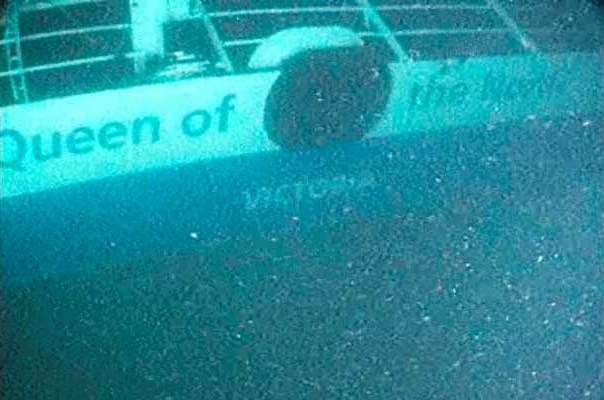VANCOUVER - The first moment anyone from the outside world knew something was amiss on the Queen of the North passenger ferry, crippled and taking on water off the northern coast of British Columbia, came at roughly 22 minutes past midnight on a windy March night seven years ago.
"Traffic: this is Queen of the North, Queen of the North, Queen of the North," the ship's second officer, Kevin Hilton, called into his marine radio.
"Traffic, traffic: we have run aground south of Sainty Point, several miles south of Sainty Point. Stand by for position."
The ship had just struck Gil Island. About 20 minutes before that, the vessel missed a crucial turn as it sailed down B.C.'s Inside Passage with 101 people on board.
Audio recordings of what happened next were played Wednesday at the criminal negligence trial for Karl Lilgert, who was fourth officer on the ship. Lilgert is charged in connection to the deaths of two passengers, who haven't been seen since the ferry sank on March 22, 2006.
The recordings suggest there was no sign of trouble, at least none reported to marine operators, as the ship sailed on a collision course toward Gil Island.
They also show how fast the situation turned catastrophic: within minutes, the ship was listing to one side, passengers were being herded onto life boats and nearby fishing vessels were summoned to the area to help.
The trial has heard that Lilgert was alone on the bridge with quartermaster Karen Bricker, his former lover, at the time of the collision. The audio recordings suggest the accident wasn't reported on the radio until Hilton returned to the bridge.
In the minute or so that followed, a marine officer in Prince Rupert, where the ship had departed from four hours earlier, struggled to pin down the ship's position.
Within two minutes, the ferry was asking for help,
"We require assistance," said a crew member on the ship, identified in a court transcript as Janice O'Neill.
"And confirm that you are not taking on water?" asked marine operator Kim Brownlee, who testified about the recordings on Wednesday.
"We are taking on water," replied O'Neill.
And then, from the ship's captain, Colin Henthorne: "Our list is increasing. We need assistance immediately."
Several minutes after that, the evacuation was in full swing.
"How many people do you have on board," asked Brownlee.
"We have 101 persons on board the ship," replied O'Neill. "We are proceeding, readying life boats and life rafts."
Meanwhile, operators of a number of fishing vessels offered to help. Some were within a half hour from the sinking vessel. Others were farther, in some cases hours away, but told to head to the scene anyway.
About 12 minutes after the collision was first reported, a resident in a tiny First Nations community north of Gil Island took to the radio.
"This is Hartley Bay," said resident Eddie Robinson. "We're trying to get some boats to come out."
Eventually, the community had at least three fast-response boats in the water and two 10-metre fishing vessels headed to the Queen of the North.
As those boats were on the way, an ominous message came from the ferry.
"We have abandoned the ship now," said chief officer Richard St. Pierre. "We have five life rafts, one rescue boat and two life boats in the water."
The passengers were taken either to Hartley Bay, where they were put up in a local community centre, or a coast guard ship, the Sir Wilfred Laurier, that was already in the area.
Throughout the morning, marine traffic operators, people involved in the rescue, and rescue officials in the Victoria area struggled to confirm both how many people had been on board the ship and how many made it off.
The tally of passengers and crew on the ferry fluctuated, alternating between 101 and 102, the trial heard. So did the number of missing one, maybe two, or perhaps none at all.
In the end, 99 passengers and crew survived the sinking. Two passengers, Gerald Foisy and Shirley Rosette, were never seen again and are presumed drowned.
The jury heard about two hours of audio recordings on Wednesday.
The Crown has alleged Lilgert was responsible for the missed course correction, and that he failed to take any evasive actions before the ferry struck Gil Island.
The defence has suggested Lilgert was faced with poor training, unreliable equipment and inadequate policies within BC Ferries the former Crown corporation that operates the province's ferry system.
Lilgert has pleaded not guilty to two counts of criminal negligence causing death. His trial, before a jury, is expected to last up to six months.


